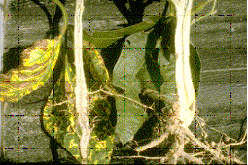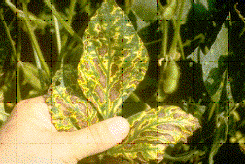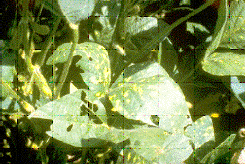Reports on Plant Diseases | RPD No. 512 - Sudden Death
Syndrome of Soybeans | May 1997 |
[ Symptoms ] [ Disease Cycle
] [ Management ]
|
Sudden Death Syndrome (SDS) of soybeans, caused by a strain of the fungus
known as Fusarium solani, is becoming a common problem throughout
Illinois, particularly when cool temperatures and rainy conditions occur
throughout the early flowering period. Losses commonly do not exceed 10-15%
of a crop, but cases have occurred where yields were reduced over 70%
due to SDS. Although most cases of SDS occur in the southern half of the
state, there have been reports of SDS in most Illinois counties when weather
conditions favor disease development.
The name sudden death syndrome is somewhat misleading, since the disease
may take up to 14 days to fully develop. However, symptoms may not be
readily apparent until the disease is well advanced and plants have actually
begun to defoliate. Time from defoliation to death is short and may account
for the "suddenness" of this disease.
SDS occurs throughout the Mississippi River basin where soybeans are
grown. Soybean researchers in other states have reported isolating the
pathogen from soybean roots but symptoms were not consistent with those
for SDS found in the Midwest. There is no clear indication at this time
if the disease will be restricted northward by cold weather or if it will
continue to expand into other northern or southeastern states. No environmental
studies have been made at this time to fully define the range of conditions
that this strain of Fusarium can tolerate, although other
Fusarium species are widely adapted and can tolerate temperatures
well below freezing.
SDS can vary greatly in appearance and severity from year to year. The
disease is favored by cool, rainy weather through the first half of the
growing season. Hot and dry conditions limit the development of the disease
but will not totally eliminate it from an area.
Early planted soybeans tend to be more heavily damaged than later planted
beans because of the more favorable conditions for infection by the Fusarium
fungus early in the season. Thus, delaying planting until after soils
warm and dry can help reduce the impact of the disease. Losses can also
be reduced by planting full-season or late maturing soybeans. Where possible,
the use of several planting periods or different maturities within a group
or different maturity groups is also suggested. No pesticides have been
found to control the disease. Research has also shown that SDS is far
more likely to appear in a field with moderate to high populations of
the soybean cyst nematode (SCN). Although there does not appear to be
a direct relationship of SDS to SCN, the nematode acts as an additional
stress on the plants, making them more subject to infection and colonization.
Management of SCN will not eliminate SDS but can significantly reduce
the levels of losses. SCN-resistant soybeans are a helpful method of reducing
this major stress on the plants.
Current research indicates that soybeans may vary greatly in their response
to infection by SDS. Although no varieties are yet labelled as resistant,
there are a number of soybeans which yield well even when infected. Research
is ongoing to determine factors in these beans which influence SDS levels.
Fusarium fungi can colonize corn and other crops commonly
planted in Illinois. In addition, this fungus can exist for many years
without a host crop surviving in the soil as mycelium or by colonizing
crop debris. However, this survival ability does not directly relate or
predict disease appearance or losses. Like many other soilborne diseases,
SDS losses are greatly dependent on environment, time of infection, and
the general vigor of the soybean crop.
|

Figure
1. Healthy plant on right; left plant shows weak stem and discolored
leaves.

Figure 2.
Early leaf symptoms (flecking) on soybean leaves.

Figure 3.
Late leaf symptoms.
|
Back to Top
Symptoms
SDS symptoms begin as small yellow spots on the upper leaves of the plants.
These may either not be noticed or may be diagnosed as another disease.
Spots gradually enlarge and develop a brown necrotic (dead) center. They
continue to enlarge until all of the interveinal tissues are killed, leaving
a green vein pattern on the leaf. The time involved for this symptom to
develop is dependent upon the weather and the variety of soybean in the
field.
Defoliation follows the development of interveinal necrosis. Petioles
(leaf stems) remain firmly attached to the plant after defoliation. This
may occur late in the season and be mistaken for early maturity.
Flower and pod abortion is common with SDS. Infected plants generally
set some pods on the lower stem area and abort the majority of their other
flowers. Lower pods may or may not fully ripen depending on the time of
infection.
A diagnostic feature of SDS is found by splitting the stems lengthwise
and examining the pith. The central pith should be white with no discoloration
or decay. A slight browning of the vascular system lying just outside
of the pith area is often seen.
SDS foliar symptoms can be confused with those of brown stem rot (BSR),
another fungal disease of soybeans. Certain varieties of soybeans infected
with BSR can exhibit leaf symptoms identical to those of SDS. However,
brown stem rot infections produce a dark brown discoloration of the pith.
BSR, favored by cool, wet weather, is commonly found in northern Illinois
while SDS is more common in the south. Both diseases can be found in the
central parts of Illinois. An accurate diagnosis is needed to develop
control programs since BSR can be controlled by resistant varieties, not
possible with SDS.
Roots may also exhibit some decay and discoloration. Nodulation is often
sparse on SDS-infected plants. However, these features are commonly seen
with many other root-rot diseases and cannot be considered diagnostic.
|
Back to Top
|
Fusarium fungi commonly survive in crop debris and as mycelium in the soil.
SDS is not known to be transmitted through seed. Since the primary inoculum
occurs in the soil, movement of soil or infected plant debris could transfer
the disease as well.
The exact time of infection for SDS is not known, although research has
shown that the causal fungus can be isolated from plant roots as early
as 40 days after planting, even though symptoms do not appear until much
later. Fusarium fungi commonly invade plant roots through wounds caused
by insects, nematodes or mechanical injuries. Conditions favoring infection
by Fusarium fungi are saturated soils and temperatures of
55 to 65 F, with maximum infectivity at the lower end of this range.
After colonization, it is believed that this fungus produces a toxin
which is translocated to the upper leaves, causing the characteristic
spotting, interveinal necrosis, and other symptoms. The fungus survives
in root tissues and as mycelium and spores in the soil.
Stresses, especially those affecting root development, may increase losses
due to SDS. The soybean cyst nematode, in particular, predisposes plants
to infection by producing feeding wounds in the roots as well as affecting
plant vigor. Research in Mississippi has also shown that the causal fungus
can be isolated both externally and internally from SCN. Thus, fields
with moderate to high SCN populations are much more likely to have SDS
infections.
Development of SDS depends upon many factors, including planting date,
variety of soybean, and presence or absence of additional stresses. Tillage
does not seem to have a direct affect on SDS levels. However, since reduced
tillage (especially zero-till) produces additional residue levels which
may not decay during the winter and causes slower warming and drying of
the soil in spring (conditions favorable to the Fusarium
fungus), growers should be aware that these conditions can influence the
level of SDS.
Back to Top
|
SDS is a difficult disease to manage. At present, there are no labelled resistant
varieties, although many soybeans do show differences in reaction to SDS. No fungicide
or nematicide will adequately reduce SDS levels in a field. Tillage does not appear
to directly impact the disease, although environmental conditions favoring wet
or cool soils may increase chances of infections.
Follow these guidelines to lessen the impact of SDS:
-
Learn to identify SDS in the field. Symptoms may appear much as those
of other, more common, diseases.
-
Select varieties of soybeans that will mature at different times. Use either
different maturities within a maturity group or use different maturity groups.
-
Extend planting times so that all beans are not at the same growth stage
at the same time. However, do not wait past the suggested time for your
area of the state.
-
Where feasible, improve drainage in the field and reduce soil compaction.
Tiling or ditching will remove excess water and can help lessen the impact
of other soybean diseases.Reduction of soil compaction will help drainage
and also improve root growth and development, two factors that can affect
SDS development.
-
Crop rotation is of limited value. SDS has been found in continuous soybeans,
soybeans following one or two years of corn or milo, and in fields that
had been out of beans for many years. Fusarium fungi can persist for many
years in the soil, even without a host crop. However, continuous soybeans
is not recommended since this can increase other diseases.
- Control and monitor soybean cyst nematode populations. Although not directly
involved with SDS, SCN populations over the suggested threshold will affect
plant growth and development. Use soil sampling, resistance, and crop rotation
to reduce SCN levels. Nematicides are not recommended due to handling and
environmental hazards and unreliable performance.
Back to Top
For further information concerning
diseases of crucifers and other vegetables, contact Mohammad Babadoost, Extension
Specialist in Fruit and Vegetable Diseases, Department of Crop Sciences, University
of Illinois at Urbana-Champaign. University
of Illinois Extension provides equal opportunities in programs and employment.
|



